
Inaugural games of the Flavian Amphitheatre
Encyclopedia
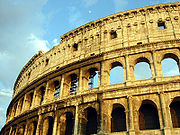
Anno Domini
and Before Christ are designations used to label or number years used with the Julian and Gregorian calendars....
80, on the orders of the Roman Emperor
Roman Emperor
The Roman emperor was the ruler of the Roman State during the imperial period . The Romans had no single term for the office although at any given time, a given title was associated with the emperor...
Titus
Titus
Titus , was Roman Emperor from 79 to 81. A member of the Flavian dynasty, Titus succeeded his father Vespasian upon his death, thus becoming the first Roman Emperor to come to the throne after his own father....
, to celebrate the completion of the Colosseum
Colosseum
The Colosseum, or the Coliseum, originally the Flavian Amphitheatre , is an elliptical amphitheatre in the centre of the city of Rome, Italy, the largest ever built in the Roman Empire...
, then known as the Flavian Amphitheatre . Vespasian
Vespasian
Vespasian , was Roman Emperor from 69 AD to 79 AD. Vespasian was the founder of the Flavian dynasty, which ruled the Empire for a quarter century. Vespasian was descended from a family of equestrians, who rose into the senatorial rank under the Emperors of the Julio-Claudian dynasty...
began construction of the amphitheatre
Amphitheatre
An amphitheatre is an open-air venue used for entertainment and performances.There are two similar, but distinct, types of structure for which the word "amphitheatre" is used: Ancient Roman amphitheatres were large central performance spaces surrounded by ascending seating, and were commonly used...
around AD 70, and it was completed by Titus soon after Vespasian's death in AD 79. After Titus' reign began with months of disasters – including the eruption of Mount Vesuvius
Mount Vesuvius
Mount Vesuvius is a stratovolcano in the Gulf of Naples, Italy, about east of Naples and a short distance from the shore. It is the only volcano on the European mainland to have erupted within the last hundred years, although it is not currently erupting...
, a fire in Rome, and an outbreak of plague – he inaugurated the building with lavish games which lasted for more than a hundred days, perhaps partially in an attempt to appease the Roman public and the gods.
Little documentary evidence of the nature of the games (ludi
Ludi
Ludi were public games held for the benefit and entertainment of the Roman people . Ludi were held in conjunction with, or sometimes as the major feature of, Roman religious festivals, and were also presented as part of the cult of state.The earliest ludi were horse races in the circus...
) remains. They appear to have followed the standard format of the Roman games: animal entertainments in the morning session, followed by the executions of criminals around midday, with the afternoon session reserved for gladiatorial combats and recreations of famous battles. The animal entertainments, which featured creatures from throughout the Roman Empire
Roman Empire
The Roman Empire was the post-Republican period of the ancient Roman civilization, characterised by an autocratic form of government and large territorial holdings in Europe and around the Mediterranean....
, included extravagant hunts and fights between different species. Animals also played a role in some executions which were staged as recreations of myths and historical events. Naval battles formed part of the spectacles but whether these took place in the amphitheatre or on a lake that had been specially constructed by Augustus
Augustus
Augustus ;23 September 63 BC – 19 August AD 14) is considered the first emperor of the Roman Empire, which he ruled alone from 27 BC until his death in 14 AD.The dates of his rule are contemporary dates; Augustus lived under two calendars, the Roman Republican until 45 BC, and the Julian...
is a topic of debate among historians.
Only three contemporary or near-contemporary accounts of the games survive. The works of Suetonius
Suetonius
Gaius Suetonius Tranquillus, commonly known as Suetonius , was a Roman historian belonging to the equestrian order in the early Imperial era....
and Cassius Dio focus on major events, while Martial
Martial
Marcus Valerius Martialis , was a Latin poet from Hispania best known for his twelve books of Epigrams, published in Rome between AD 86 and 103, during the reigns of the emperors Domitian, Nerva and Trajan...
provides some fragments of information on individual entertainments and the only detailed record of a gladiatorial combat in the arena to survive to the present day: the fight between Verus
Verus (gladiator)
Originally from Moesia, Verus was a slave who became a well-known gladiator during the reigns of the Emperors Vespasian and Titus in the latter part of the 1st century...
and Priscus
Priscus (Gladiator)
Priscus was a Roman gladiator of Celtic origins. His combat with his friend Verus was the highlight of the opening day of the games conducted by Titus to inaugurate the Flavian Amphitheatre in AD 80, and was recorded in a laudatory poem by Martial — the only detailed description of a gladiatorial...
.
Construction of the amphitheatre
Construction of the Colosseum started under Vespasian in an area on the floor of a low valley between the CaelianCaelian Hill
The Caelian Hill is one of the famous Seven Hills of Rome. Under reign of Tullus Hostilius, the entire population of Alba Longa was forcibly resettled on the Caelian Hill...
, Esquiline
Esquiline Hill
The Esquiline Hill is one of the celebrated Seven Hills of Rome. Its southern-most cusp is the Oppius .-Etymology:The origin of the name Esquilino is still under much debate. One view is that the Hill was named after the abundance of holm-oaks, exculi, that resided there...
and Palatine
Palatine Hill
The Palatine Hill is the centermost of the Seven Hills of Rome and is one of the most ancient parts of the city...
hills. The site had been devastated by the Great Fire of Rome
Great Fire of Rome
The Great Fire of Rome was an urban fire that occurred beginning July 19, AD 64.-Background:According to Tacitus, the fire spread quickly and burned for six days. Only four of the fourteen districts of Rome escaped the fire; three districts were completely destroyed and the other seven suffered...
in AD 64 under the Emperor Nero
Nero
Nero , was Roman Emperor from 54 to 68, and the last in the Julio-Claudian dynasty. Nero was adopted by his great-uncle Claudius to become his heir and successor, and succeeded to the throne in 54 following Claudius' death....
and later redeveloped for his personal enjoyment with the construction of a huge artificial lake, Domus Aurea
Domus Aurea
The Domus Aurea was a large landscaped portico villa, designed to take advantage of artificially created landscapes built in the heart of Ancient Rome by the Emperor Nero after the Great Fire of Rome had cleared away the aristocratic dwellings on the slopes of the Palatine...
, and a colossal statue of himself
Colossus of Nero
The Colossus Neronis was an enormous, 30 m bronze statue that the Emperor Nero erected in the vestibule of his Domus Aurea, the imperial villa complex on the Palatine Hill. It was modified by Nero's successors into a statue of the sun god Sol Invictus. It is last mentioned in the 4th century AD...
.
Vespasian started his own redevelopment of the site around AD 70 to 72, possibly funding the construction with booty seized after the Roman victory in the First Jewish-Roman War
First Jewish-Roman War
The First Jewish–Roman War , sometimes called The Great Revolt , was the first of three major rebellions by the Jews of Judaea Province , against the Roman Empire...
in AD 70. The lake was filled and the site designated as the location for the Flavian Amphitheatre. By reclaiming the land appropriated by Nero for the site for his amphitheatre, Vespasian at once made both a popular gesture and placed a symbol of his power at the heart of the city. Gladiatorial schools (ludi) and other support buildings were later constructed within the former grounds of the Domus Aurea, much of which had been torn down.
Vespasian died just before the amphitheatre was completed. The building had reached the third storey and Titus was able to finish construction of both the amphitheatre and adjacent public baths
Thermae
In ancient Rome, thermae and balnea were facilities for bathing...
(which were to be known as the Baths of Titus
Baths of Titus
The Baths of Titus were public baths built in Rome in 81 by Emperor Titus.The baths sat in the base of the Esquiline hill, an area of parkland and luxury estates which had been taken over by Nero for his Golden House or Domus Aurea...
) within a year of Vespasian's death.
Reign of Titus
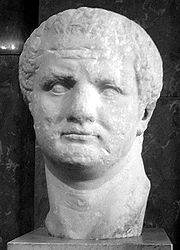
Mount Vesuvius
Mount Vesuvius is a stratovolcano in the Gulf of Naples, Italy, about east of Naples and a short distance from the shore. It is the only volcano on the European mainland to have erupted within the last hundred years, although it is not currently erupting...
had erupted, destroying Pompeii
Pompeii
The city of Pompeii is a partially buried Roman town-city near modern Naples in the Italian region of Campania, in the territory of the comune of Pompei. Along with Herculaneum, Pompeii was destroyed and completely buried during a long catastrophic eruption of the volcano Mount Vesuvius spanning...
, Herculaneum
Herculaneum
Herculaneum was an ancient Roman town destroyed by volcanic pyroclastic flows in AD 79, located in the territory of the current commune of Ercolano, in the Italian region of Campania in the shadow of Mt...
, Stabiae
Stabiae
Stabiae was an ancient Roman town, located close to the modern town of Castellammare di Stabia approximately 4.5 km southwest of Pompeii. It was positioned on a 50 m high headland overlooking the Gulf of Naples...
, and Oplontis
Oplontis
Oplontis was a town near Pompeii, in the Roman Empire. On August 24, AD 79, the eruption of Mount Vesuvius buried it under a deep layer of ash. It is today the location of the Villa Poppaea, the villa of the wife of Emperor Nero, which was excavated in the mid-20th century and is open to the...
; a fire had burned in the city of Rome
Rome
Rome is the capital of Italy and the country's largest and most populated city and comune, with over 2.7 million residents in . The city is located in the central-western portion of the Italian Peninsula, on the Tiber River within the Lazio region of Italy.Rome's history spans two and a half...
for three days and three nights causing substantial damage and destroying the Temple of Jupiter, recently restored by Vespasian; and there had been an outbreak of plague
Bubonic plague
Plague is a deadly infectious disease that is caused by the enterobacteria Yersinia pestis, named after the French-Swiss bacteriologist Alexandre Yersin. Primarily carried by rodents and spread to humans via fleas, the disease is notorious throughout history, due to the unrivaled scale of death...
which was said to be the worst the city had ever endured. To dedicate the amphitheatre and the baths, and probably in an attempt to mollify both the Roman public and the gods, Titus held lavish games which lasted for more than a hundred days.
Sources
Little documentary evidence of the games remains; contemporary and near-contemporary writings mostly record the major details and concentrate on the opening days. The poet MartialMartial
Marcus Valerius Martialis , was a Latin poet from Hispania best known for his twelve books of Epigrams, published in Rome between AD 86 and 103, during the reigns of the emperors Domitian, Nerva and Trajan...
gives the most complete and only truly contemporary account in the form of his De Spectaculis ("On the Spectacles"), a somewhat sycophantic series of epigram
Epigram
An epigram is a brief, interesting, usually memorable and sometimes surprising statement. Derived from the epigramma "inscription" from ἐπιγράφειν epigraphein "to write on inscribe", this literary device has been employed for over two millennia....
s detailing the individual events of the games as an illustration of Titus' power and benevolence. Much of the work is concerned with praising Titus, and there have been difficulties with authenticating, dating and translating various portions, but Martial does give details of events not covered by other sources and the only complete record of a gladiatorial combat in the arena to survive to the present day.
The historian Suetonius
Suetonius
Gaius Suetonius Tranquillus, commonly known as Suetonius , was a Roman historian belonging to the equestrian order in the early Imperial era....
was born in about AD 70 and started writing around AD 100. He was a child at the time of the games, but it is possible that he was born and raised in Rome, so he may have witnessed the inaugural games first-hand. His De Vita Caesarum (Lives of the Caesars, known also as The Twelve Caesars or Lives of the Twelve Caesars) probably completed around AD 117 to 127, includes some detail on the opening days of the games. Later in his history of Titus he reveals further information about the games. Suetonius' histories of the early Caesars have been criticised for being based on rumour and gossip rather than accurate historical sources, and he often reports from sources which contradict each other without attempting to analyse their quality or accuracy. However, he is generally regarded as a thorough scholar and has been praised for his balanced treatment of his subjects.
The only other major source of information on the games is Cassius Dio who lived in the latter second and early third centuries. His History of Rome spans 80 books, many of which survive only as fragments, and took 22 years to complete. He is noted for his attention to detail in administrative affairs, but for major events his writing can be impressionistic, with a greater emphasis on his interpretation of the events' significance in the wider historical context than on facts and figures. His sources are varied: he relies on many of the major commentators but also seems to have paid close attention to public records. The sources for his account of the games of Titus are unknown.
Animal entertainments
Animal entertainments formed a central part of the games and normally took place in the morning. Dio says that over the course of the inaugural games "animals both tame and wild were slain to the number of nine thousand; and women (not those of any prominence, however) took part in dispatching them." Eutropius, who wrote in the later part of the fourth century, records that 5,000 animals were slain during the games.Dio and Martial record some of the animals that were exhibited. Dio notes a hunt involving crane
Crane (bird)
Cranes are a family, Gruidae, of large, long-legged and long-necked birds in the order Gruiformes. There are fifteen species of crane in four genera. Unlike the similar-looking but unrelated herons, cranes fly with necks outstretched, not pulled back...
s and another involving four elephants, and Martial mentions elephants, lions, leopards, at least one tiger, hares, pigs, bull
Bull
Bull usually refers to an uncastrated adult male bovine.Bull may also refer to:-Entertainment:* Bull , an original show on the TNT Network* "Bull" , an episode of television series CSI: Crime Scene Investigation...
s, bears, wild boar, a rhinoceros, buffalo
Bovid
A bovid is any of almost 140 species of cloven-hoofed ruminant mammal at least the males of which bear characteristic unbranching horns covered in a permanent sheath of keratin....
and bison (most likely the wisent
Wisent
The wisent , Bison bonasus, also known as the European bison or European wood bison, is a species of Eurasian bison. It is the heaviest surviving land animal in Europe; a typical wisent is about long, not counting a tail of long, and tall. Weight typically can range from , with an occasional big...
). Other exotic animals may have been used but are not mentioned; ostriches, camels and crocodiles were commonly used in the games. Giraffes are unlikely to have been featured; Julius Caesar
Julius Caesar
Gaius Julius Caesar was a Roman general and statesman and a distinguished writer of Latin prose. He played a critical role in the gradual transformation of the Roman Republic into the Roman Empire....
had brought a single giraffe to Rome in 46 BC and another is not recorded in Europe until the Medici giraffe
Medici giraffe
The Medici giraffe was a giraffe presented to Lorenzo de Medici in 1486 possibly by al-Ashraf Qaitbay, the Burji Mamluke sultan of Egypt, in an attempt to win the support of the Medici....
in 1486. Though they were first seen in Rome only in 58 BC, and were impressive enough to be detailed in the games of Augustus
Augustus
Augustus ;23 September 63 BC – 19 August AD 14) is considered the first emperor of the Roman Empire, which he ruled alone from 27 BC until his death in 14 AD.The dates of his rule are contemporary dates; Augustus lived under two calendars, the Roman Republican until 45 BC, and the Julian...
and Commodus
Commodus
Commodus , was Roman Emperor from 180 to 192. He also ruled as co-emperor with his father Marcus Aurelius from 177 until his father's death in 180. His name changed throughout his reign; see changes of name for earlier and later forms. His accession as emperor was the first time a son had succeeded...
, there is no mention of hippopotami at Titus' games.
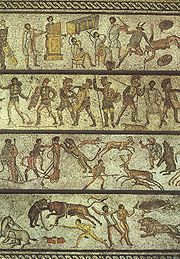
From Martial's account it appears that some of the animals were uncooperative. Although he again casts the event as a demonstration of Titus' power to command the beasts, he mentions that the lions ignored their intended prey:
The rhinoceros, too, proved difficult to handle. It was initially paraded around the arena, but became infuriated and attacked a bull, to the apparent delight of the crowd. Later, when it was supposed to fight, it had calmed down. Intended to face a company of men armed with spears and a host of other animals, it had to be goaded by "trembling trainers" until it would engage the other combatants:
Carpophorus was a skilled bestiarius
Bestiarii
Among Ancient Romans, bestiarii were those who went into combat with beasts, or were exposed to them. It is conventional to distinguish two categories of bestiarii: the first were those condemned to death via the beasts and the second were those who faced them voluntarily, for pay or glory...
, specializing in fighting animals in the arena, and is mentioned again by Martial, who compares him to Hercules
Hercules
Hercules is the Roman name for Greek demigod Heracles, son of Zeus , and the mortal Alcmene...
and praises his abilities in dispatching a bear, a leopard and a lion of "unprecedented size". A frieze from the Temple of Vespasian and Titus
Temple of Vespasian and Titus
The Temple of Vespasian and Titus is located in Rome at the western end of the Roman Forum between the Temple of Concordia and the Temple of Saturn. It is dedicated to the deified Vespasian and his son, the deified Titus. It was begun by Titus in 79 after Vespasian's death and Titus's succession...
(Templum Divi Vespasiani) in the Roman Forum
Roman Forum
The Roman Forum is a rectangular forum surrounded by the ruins of several important ancient government buildings at the center of the city of Rome. Citizens of the ancient city referred to this space, originally a marketplace, as the Forum Magnum, or simply the Forum...
shows events similar to those described by Martial. Two separate sets of decoration show a rhinoceros confronting a bull and a bestarius, possibly Carpophorus, with a spear, facing a lion and a leopard. Carpophorus was not the only beast slayer worthy of mention: another of Martial's epigrams refers to a woman equalling Hercules's feat of slaying the Nemean Lion
Nemean Lion
The Nemean lion was a vicious monster in Greek mythology that lived at Nemea. It was eventually killed by Heracles. It could not be killed with mortal weapons because its golden fur was impervious to attack...
.
While the trainers of the rhinoceros may have trembled in fear at the fate that awaited them if their animal failed to perform, and another trainer was savaged by his lion, some were more successful. One trainer was noted for his tigress which, though tame enough to lick his hand, had torn a lion to pieces, "a novelty unknown in any times". It also appears that the crowd was pleased when a bull (perhaps ridden by a bestarius) was hoisted aloft in the arena, but Martial gives little clue as to the nature of this entertainment.
Executions
Executions were a common feature of the Roman games. They took place around midday as an interlude between the animal entertainments of the morning sessions and the gladiatorial combat in the afternoon. Although the executions were seen as symbolizing Rome's power, the higher classes normally took advantage of this interval to leave the arena to dine; the Emperor ClaudiusClaudius
Claudius , was Roman Emperor from 41 to 54. A member of the Julio-Claudian dynasty, he was the son of Drusus and Antonia Minor. He was born at Lugdunum in Gaul and was the first Roman Emperor to be born outside Italy...
was criticised by some authors for not doing so, so it is unlikely that Titus would have watched this part of the show. The executions of deserters, prisoners-of-war, and criminals from the lower classes were normally crucifixions or damnatio ad bestias
Damnatio ad bestias
Damnatio ad bestias was a form of capital punishment in which the condemned were maimed on the circus arena or thrown to a cage with animals, usually lions. It was brought to ancient Rome around the 2nd century BC from Asia, where a similar penalty existed from at least the 6th century BC...
in which they would face wild animals. Scipio Aemilianus
Scipio Aemilianus Africanus
Publius Cornelius Scipio Aemilianus Africanus Numantinus , also known as Scipio Aemilianus or Scipio Africanus the Younger, was a leading general and politician of the ancient Roman Republic...
had been the first to execute criminals in this way when he had deserters from his army exposed to wild beasts in 146 BC. These executions often took the form of the re-creation of some tragic scene from history or mythology with the criminal cast in the role of the victim killed by wild beasts. Martial records one such execution, a version of the mime Laureolus by Catullus
Catullus
Gaius Valerius Catullus was a Latin poet of the Republican period. His surviving works are still read widely, and continue to influence poetry and other forms of art.-Biography:...
, in which a notorious bandit was executed by crucifixion. For the games this was adapted as a version of the legend of Prometheus
Prometheus
In Greek mythology, Prometheus is a Titan, the son of Iapetus and Themis, and brother to Atlas, Epimetheus and Menoetius. He was a champion of mankind, known for his wily intelligence, who stole fire from Zeus and gave it to mortals...
, who each day would have his liver devoured by an eagle
Eagle
Eagles are members of the bird family Accipitridae, and belong to several genera which are not necessarily closely related to each other. Most of the more than 60 species occur in Eurasia and Africa. Outside this area, just two species can be found in the United States and Canada, nine more in...
. The element of crucifixion from Catullus' mime remained, but a wild boar was substituted for the eagle from the Prometheus legend:
Another execution was staged as a cruel twist on the story of Orpheus
Orpheus
Orpheus was a legendary musician, poet, and prophet in ancient Greek religion and myth. The major stories about him are centered on his ability to charm all living things and even stones with his music; his attempt to retrieve his wife from the underworld; and his death at the hands of those who...
, who supposedly charmed the plants and flowers with his song after he lost Eurydice
Eurydice
Eurydice in Greek mythology, was an oak nymph or one of the daughters of Apollo . She was the wife of Orpheus, who loved her dearly; on their wedding day, he played joyful songs as his bride danced through the meadow. One day, a satyr saw and pursued Eurydice, who stepped on a venomous snake,...
. In the version presented at the inaugural games, the tree and animals were charmed just as in the story, except for an "unappreciative" bear which tore the minstrel to pieces. It is likely that the harmless creatures were released first to give the impression of the story proceeding as planned before the bear was released to dispatch the unfortunate criminal forced into the role of Orpheus, whose probable restraint prevented him fleeing. Ironic reinterpretations of the myths may have been popular: in addition to Orpheus' failure to charm the beasts, Martial mentions "Daedalus
Daedalus
In Greek mythology, Daedalus was a skillful craftsman and artisan.-Family:...
" being torn apart by another bear, mocking him with the words "how you must wish you had your feathers now".
Martial also suggests the rape of a woman by a bull in a re-creation of the myth of Pasiphaë
Pasiphaë
In Greek mythology, Pasiphaë , "wide-shining" was the daughter of Helios, the Sun, by the eldest of the Oceanids, Perse; Like her doublet Europa, her origins were in the East, in her case at Colchis, the palace of the Sun; she was given in marriage to King Minos of Crete. With Minos, she was the...
. Nero had provided a similar entertainment at an event he had staged using an actor dressed in the costume of a bull, though Martial claims that the act performed at the inaugural games was authentic.
Combat, hunting and racing
Dio, Suetonius and Martial all record naumachiaNaumachia
The naumachia in the Ancient Roman world referred to both the re-enactment of naval battles and the basin in which this took place....
e, the commonly used Greek term for what the Romans also called navalia proelia, re-creations of famous sea battles. While Dio claims that both the purpose-built naumachia of Augustus and the amphitheatre itself were flooded for two separate shows, Suetonius states only that the event took place on the old artificial lake (which would have been that of Augustus). Martial does not specify where the naumachiae took place, but he is clear that whatever location he is discussing could be flooded and drained at will:
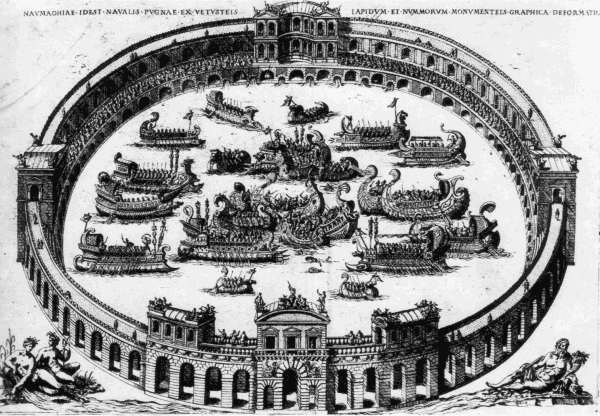
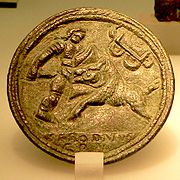
Domitian
Domitian was Roman Emperor from 81 to 96. Domitian was the third and last emperor of the Flavian dynasty.Domitian's youth and early career were largely spent in the shadow of his brother Titus, who gained military renown during the First Jewish-Roman War...
, staged sea-fights in the amphitheatre, but he had made alterations to the structure, which probably included adding the hypogeum
Hypogeum
Hypogeum or hypogaeum literally means "underground", from Greek hypo and gaia . It usually refers to an underground, non-Christian temple or a tomb...
—a complex of underground passages that may have allowed the arena to be quickly flooded and emptied. While Suetonius only records that Titus' recreations of naval battles took place, Dio gives some details:
Both Dio and Suetonius agree that gladiatorial contests and a wild-beast hunt, the venatio
Venatio
Venatio was a form of entertainment in Roman amphitheaters involving the hunting and slaying of wild animals. Exotic wild beasts from the far reaches of the Roman Empire were brought to Rome and hunts were held in the morning prior to the afternoon main event of gladiatorial duels...
, also took place at the lake area, but they again disagree on the details. Dio states this took place on the first day, with the lake covered over with planking and wooden stands erected around it, while Suetonius says the events occurred in the basin after the water had been let out. Suetonius writes that 5,000 animals were killed there in a single day. Although no record of the animals pursued in these hunts survives (Dio mentions hunts of cranes and elephants but does not give a location), larger exotic animals were popular, notably elephants, big cats and bears, though smaller game such as birds, rabbits and goats also featured.
Suetonius writes that when Domitian staged his games there were other entertainments aside from the "usual two-horse chariot races", which indicates these races probably formed part of Titus' games, and Dio tells us that there was a horse race on the second day though he gives no details of the type of race.
Only Dio's record extends to detail of the third day specifically, during which he says:
This may again suggest the amphitheatre was flooded, as the monument referred to could be an altar of Diana
Diana (mythology)
In Roman mythology, Diana was the goddess of the hunt and moon and birthing, being associated with wild animals and woodland, and having the power to talk to and control animals. She was equated with the Greek goddess Artemis, though she had an independent origin in Italy...
, or Pluto
Pluto (mythology)
In ancient Greek religion and myth, Pluto was a name for the ruler of the underworld; the god was also known as Hades, a name for the underworld itself...
, or of Jupiter Latiaris
Jupiter (mythology)
In ancient Roman religion and myth, Jupiter or Jove is the king of the gods, and the god of the sky and thunder. He is the equivalent of Zeus in the Greek pantheon....
that may have been present in the centre of the arena, but Pliny the Elder
Pliny the Elder
Gaius Plinius Secundus , better known as Pliny the Elder, was a Roman author, naturalist, and natural philosopher, as well as naval and army commander of the early Roman Empire, and personal friend of the emperor Vespasian...
mentions a bridge in connection with the lake of Augustus, suggesting there may have been an island there as well.
Verus and Priscus
Details of most of the gladiatorial combats are not recorded. Suetonius writes that they were lavish and Dio that there were both single combats and fights between groups. One fight, between the gladiators VerusVerus (gladiator)
Originally from Moesia, Verus was a slave who became a well-known gladiator during the reigns of the Emperors Vespasian and Titus in the latter part of the 1st century...
and Priscus
Priscus (Gladiator)
Priscus was a Roman gladiator of Celtic origins. His combat with his friend Verus was the highlight of the opening day of the games conducted by Titus to inaugurate the Flavian Amphitheatre in AD 80, and was recorded in a laudatory poem by Martial — the only detailed description of a gladiatorial...
, was recorded by Martial:
As usual, the tone of the epigram is somewhat fawning toward his patron, Titus, but it gives more detail than any other account of the games. It seems to imply that a draw was uncommon in gladiatorial combat at this level, but that Titus eventually yielded to the wishes of the crowd, declared the match equal, and granted both men their freedom (with the traditional presentation of the wooden sword). The traditional way of acknowledging defeat was for the yielding gladiator to raise a finger (ad digitum), and it is possible that in this case both men raised their fingers, but Martial's emphasis here is on Titus' even-handedness and generosity in granting a reprieve (missio) to the crowd's two favourites. His reference to this only happening under Titus probably alludes to the declaration of both as victors, as there is evidence that neither ties nor the survival of both gladiators in a contest were uncommon: it was expensive to train and keep a gladiator and they were not despatched lightly. There is some evidence for the existence of both Priscus and Verus, at least as names of gladiators, outside of Martial's account. A first-century graveyard in Smyrna
Smyrna
Smyrna was an ancient city located at a central and strategic point on the Aegean coast of Anatolia. Thanks to its advantageous port conditions, its ease of defence and its good inland connections, Smyrna rose to prominence. The ancient city is located at two sites within modern İzmir, Turkey...
contains the grave of a gladiator named Priscus, and Verus' name is etched on a marble slab from Ferentinum, recording a gladiatorial contest. The details of Verus' fights are unfortunately not legible. While neither of these may be the Priscus and Verus mentioned by Martial they do attest to the use of these names by gladiators.
Martial's mention of gift-giving is repeated in the account by Dio, who says that Titus would throw wooden balls into the crowd from his seat in the box at the north end of the arena. These balls were inscribed with a description of a gift, either food, clothing, slaves, pack animals, horse, cattle, or gold or silver vessels. Anybody who caught one could hand over the ball to an official who would provide the named gift in return. This was not unusual: Suetonius mentions that Nero did the same, giving 1,000 birds daily, as well as food parcels, and vouchers for various extravagant gifts.
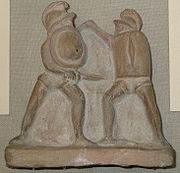
Later events
Some of Suetonius' other comments on Titus' reign mention the baths and events in the amphitheatre. Since Titus did not survive long after the end of the opening games, it is likely that these events took place during the days of the inauguration. Suetonius says that Titus promised for one day to forgo his own preferences and allow the crowd to decide the fate of the gladiators competing in the arena. He admired the ThracianThraex
The Thraex , or Thracian, was a type of Roman gladiator, armed in the Thracian style with small rectangular shield called a parmula and a very short sword with a slightly curved blade called a sica , intended to maim an opponent's unarmoured back...
gladiators, and while arguing passionately with the crowd on the subject, did not let his preferences sway him from his promise. He had some informers and their managers whipped and paraded in the arena. Some were sold as slaves in an auction and others sent away to "the most forbidding islands". Suetonius also records that Titus invited some senator
Roman Senate
The Senate of the Roman Republic was a political institution in the ancient Roman Republic, however, it was not an elected body, but one whose members were appointed by the consuls, and later by the censors. After a magistrate served his term in office, it usually was followed with automatic...
s, whom he had pardoned for plotting against him, to sit with him during one of the days of the games, and to inspect the swords of the gladiators, a statement that is reinforced to some degree by Dio who remarks that Titus had no senators put to death during his reign.
On the last day of the games, Titus wept openly in view of the public in the amphitheatre. According to Dio, Titus died the following day, after officially dedicating the amphitheatre and the baths. Suetonius says that he had set out for the Sabine
Sabine
The Sabines were an Italic tribe that lived in the central Appennines of ancient Italy, also inhabiting Latium north of the Anio before the founding of Rome...
territories after the games but collapsed and died at the first posting station.

